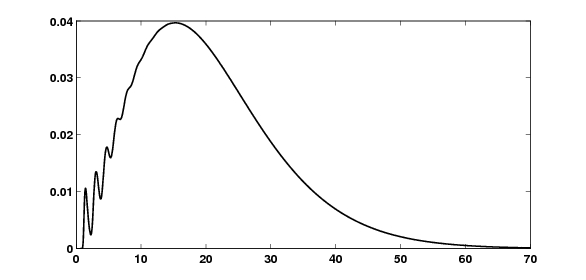Panjer recursion
The Panjer recursion is an algorithm to compute the probability distribution approximation of a compound random variable [math]\displaystyle{ S = \sum_{i=1}^N X_i\, }[/math] where both [math]\displaystyle{ N\, }[/math] and [math]\displaystyle{ X_i\, }[/math] are random variables and of special types. In more general cases the distribution of S is a compound distribution. The recursion for the special cases considered was introduced in a paper [1] by Harry Panjer (Distinguished Emeritus Professor, University of Waterloo[2]). It is heavily used in actuarial science (see also systemic risk).
Preliminaries
We are interested in the compound random variable [math]\displaystyle{ S = \sum_{i=1}^N X_i\, }[/math] where [math]\displaystyle{ N\, }[/math] and [math]\displaystyle{ X_i\, }[/math] fulfill the following preconditions.
Claim size distribution
We assume the [math]\displaystyle{ X_i\, }[/math] to be i.i.d. and independent of [math]\displaystyle{ N\, }[/math]. Furthermore the [math]\displaystyle{ X_i\, }[/math] have to be distributed on a lattice [math]\displaystyle{ h \mathbb{N}_0\, }[/math] with latticewidth [math]\displaystyle{ h\gt 0\, }[/math].
- [math]\displaystyle{ f_k = P[X_i = hk].\, }[/math]
In actuarial practice, [math]\displaystyle{ X_i\, }[/math] is obtained by discretisation of the claim density function (upper, lower...).
Claim number distribution
The number of claims N is a random variable, which is said to have a "claim number distribution", and which can take values 0, 1, 2, .... etc.. For the "Panjer recursion", the probability distribution of N has to be a member of the Panjer class, otherwise known as the (a,b,0) class of distributions. This class consists of all counting random variables which fulfill the following relation:
- [math]\displaystyle{ P[N=k] = p_k= \left(a + \frac{b}{k} \right) \cdot p_{k-1},~~k \ge 1.\, }[/math]
for some [math]\displaystyle{ a }[/math] and [math]\displaystyle{ b }[/math] which fulfill [math]\displaystyle{ a+b \ge 0\, }[/math]. The initial value [math]\displaystyle{ p_0\, }[/math] is determined such that [math]\displaystyle{ \sum_{k=0}^\infty p_k = 1.\, }[/math]
The Panjer recursion makes use of this iterative relationship to specify a recursive way of constructing the probability distribution of S. In the following [math]\displaystyle{ W_N(x)\, }[/math] denotes the probability generating function of N: for this see the table in (a,b,0) class of distributions.
In the case of claim number is known, please note the De Pril algorithm.[3] This algorithm is suitable to compute the sum distribution of [math]\displaystyle{ n }[/math] discrete random variables.[4]
Recursion
The algorithm now gives a recursion to compute the [math]\displaystyle{ g_k =P[S = hk] \, }[/math].
The starting value is [math]\displaystyle{ g_0 = W_N(f_0)\, }[/math] with the special cases
- [math]\displaystyle{ g_0=p_0\cdot \exp(f_0 b) \quad \text{ if } \quad a = 0,\, }[/math]
and
- [math]\displaystyle{ g_0=\frac{p_0}{(1-f_0a)^{1+b/a}} \quad \text{ for } \quad a \ne 0,\, }[/math]
and proceed with
- [math]\displaystyle{ g_k=\frac{1}{1-f_0a}\sum_{j=1}^k \left( a+\frac{b\cdot j}{k} \right) \cdot f_j \cdot g_{k-j}.\, }[/math]
Example
The following example shows the approximated density of [math]\displaystyle{ \scriptstyle S \,=\, \sum_{i=1}^N X_i }[/math] where [math]\displaystyle{ \scriptstyle N\, \sim\, \text{NegBin}(3.5,0.3)\, }[/math] and [math]\displaystyle{ \scriptstyle X \,\sim \,\text{Frechet}(1.7,1) }[/math] with lattice width h = 0.04. (See Fréchet distribution.)
As observed, an issue may arise at the initialization of the recursion. Guégan and Hassani (2009) have proposed a solution to deal with that issue .[5]
References
- ↑ Panjer, Harry H. (1981). "Recursive evaluation of a family of compound distributions.". ASTIN Bulletin (International Actuarial Association) 12 (1): 22–26. doi:10.1017/S0515036100006796. http://www.casact.org/library/astin/vol12no1/22.pdf.
- ↑ CV, actuaries.org; Staff page, math.uwaterloo.ca
- ↑ Vose Software Risk Wiki: http://www.vosesoftware.com/riskwiki/Aggregatemodeling-DePrilsrecursivemethod.php
- ↑ De Pril, N. (1988). "Improved approximations for the aggregate claims distribution of a life insurance portfolio". Scandinavian Actuarial Journal 1988 (1–3): 61–68. doi:10.1080/03461238.1988.10413837.
- ↑ Guégan, D.; Hassani, B.K. (2009). "A modified Panjer algorithm for operational risk capital calculations". Journal of Operational Risk 4 (4): 53–72. doi:10.21314/JOP.2009.068.
External links
 |


